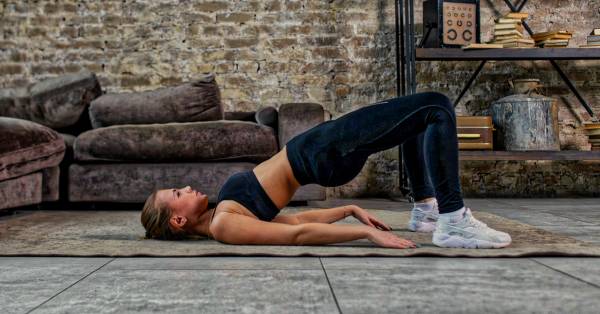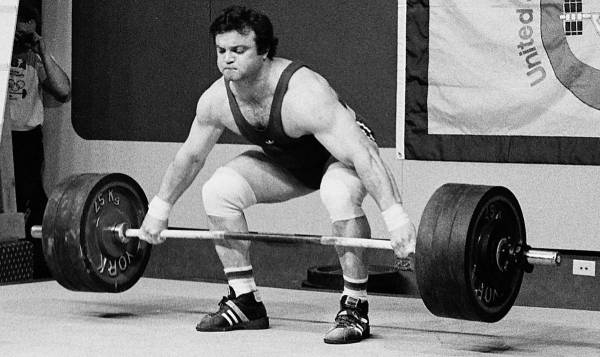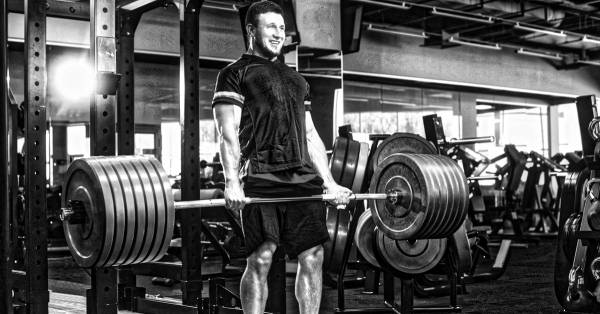A hip hinge is a movement (flexion and extension) through the hip joint, keeping a neutral spine and the knees slightly flexed. This positioning and movement pattern allows for safe movement in a variety of situations and provides the ability to effectively move large loads. Our posterior chain has incredible power if we harness it correctly and move efficiently. So, what special considerations do you need to make when training the hip hinge?
We invited strength coach and powerlifter, Patrick McCormic, to join us on this conversation, and help us build a 360 degree view of all the considerations in training the hip hinge.
Patrick McCormic
Whether you’re training an athlete or an average gym goer, properly programming the hip hinge will increase your a trainee’s performance in and out of the gym as well as give them an attractive, developed backside. The hip hinge describes hip function as flexion followed by extension. In this broad sense, even though as a powerlifter it pains me to admit it, there are many more hinges than the deadlift. In fact, depending on a number of factors, including but not limited to your trainee’s training age, goals, past injuries etc, barbell deadlifts might not be the best option.
There are several things to consider when programming the hip hinge. Foremost, is the trainee population. Are you dealing with an athlete that needs to be strong and explosive on the court/field? Do you have a member of the general pop who wants to feel stronger? Or do you have someone who is recovering from an injury or has discomfort with traditional lifts? Each individual situation requires an individual solution.
For the coach of an athlete, performance on the field or court is of paramount importance. All effort and exercises in the gym should be geared towards making the athlete more proficient at their sport. To that end, proper programming of the hip hinge should be directed toward building two attributes; the first being absolute strength, or maximum force production with no time limit, and the second being power, or maximum force production per unit time. As these traits exist at opposite ends of the force-velocity curve, training.
For exercises directed at increasing absolute strength/max force output, the most effective hip hinge modality is the deadlift; conventional, sumo, strongman, trap bar, etc. The deadlift will add muscle mass and increase strength and performance. Caveats to programming the deadlift variations depend mostly on the training age and body type of the athlete. Athletes with a younger training age will usually require more frequency and higher volume to derive maximum benefit from the deadlift, whereas larger and more experienced athletes require less frequent sessions and lower volume.
Training an athlete for power will involve the use of submaximal weights, about 20-40% of max, at high velocities, as high as 1.5 m/s. Effective exercise selection will depend on the qualifications of the athlete with the most qualified athletes performing variations of the Olympic lifts, specifically power or hang/power variations of the clean and snatch. Less qualified athletes, those with less experience in weightlifting, may benefit more from specific weightlifting exercises like high pulls and snatch/panda pulls from different starting positions. kettlebell exercises, especially the swing and clean and snatch variations, are excellent substitutions for developing power.
Hip dominant exercises create some sort of armory between agonist and antagonist muscles (namely, a better H:Q ratio) helping to prevent injuries and to improve performance.
Antonio Squillante
Hip dominant movements such as the one described by Patrick are extremely important to strengthen the hamstrings, the glutes as well as the musculature of the core. They are helpful in developing the “powerhouse”,” – the hip extensor complex that connects the lower body with the torso representing- the anatomical linkage between lower and upper extremity, the “bridge” to transfer that helps to transfer force from the ground up in any athletic-like movement: a. A stronger “powerhouse” means more power and better movement efficiency. By pivoting around the coxo-femoral joint, hip hinge exercises combine active hip extension (- the concentric part of the movement) – together with the co-contraction of the abdominal wall, the “brace” needed to prevent excessive flexion of the spine (anti-flexion, a terminology that became pretty popular since Dr.McGill changed our perspective on core training).
Hip hinge exercises also play an important role in counterbalancing the excessive amount of quad-dominant, pushing-like movements commonly used to develop the musculature of the lower extremity. Hip dominant exercises create some sort of armory between agonist and antagonist muscles (namely, a better H:Q ratio) helping to prevent injuries and to improve performance. These movements are particularly efficient in developing overall strength and power as well as intramuscular coordination and balance between the agonist and the antagonist bi-articulate muscles acting around the coxo-femoral joint and the knee joint.
Despite the many benefits associated with hip hinge movements, lack of specificity – in the biomechanical sense of the word, according to the dynamic correspondence model propose by Verkhoshansky and Siff in 1999 (Supertraining) – makes these exercises particularly indicated during the off season, to develop overall strength and power as well as intramuscular coordination and balance between the agonist and the antagonist bi-articulate muscles acting around the coxo-femoral joint and the knee joint.
As the season approaches, however, sport specific exercise involving the unilateral and bilateral, explosive triple extension of ankles, knees, and hips in the three planes of motions should replace movements that tend to isolate one specific joint and/or one degree of freedom.
Exercises like back extensions, cable pull throughs, Kettlebell deadlifts, DB deadlifts etc effectively introduce the body to the hip hinge in the upright position.
Patrick McCormic
For a member of the general population, training presents different challenges. For most, the goal is simply to get stronger. Training such a trainee allows you more latitude for programming hip hinge variations as well as more progressions.
For the most inexperienced trainees hip hinging can begin on the floor and be as simple as a supine double hip bridge. Progression can be facilitated by simply increasing ROM, adding implements like sliders or a suspension trainer as well as single-leg or weighted exercises.
Once competence is established on the floor, or for more qualified trainees, programming can progress to standing variations. Exercises like back extensions, cable pull throughs, kettlebell deadlifts, DB deadlifts etc effectively introduce the body to the hip hinge in the upright position.

The most challenging hip hinge variations will be reserved for the most qualified trainees. Exercises like barbell deadlifts even the Olympic lifts and their derivatives can be programmed as strength and skill improve.
As a result of a stagnant lifestyle, even the simplest of traditional exercises such as the squat and deadlift can be too advanced to begin with.
Ted Sloan
It is important to implement progressions when dealing with any trainee, but especially with traditional personal training. Often times this category of trainee can come to you with little or no recent exercise history. As a result of a stagnant lifestyle, even the simplest of traditional exercises such as the squat and deadlift can be too advanced to begin with. When it comes to the hip hinge, this can be even more important; there are many factors that can affect this movement, especially considering it is one of the more challenging movements to teach some trainees. Hamstring length, hip flexor length, core stability, and proprioception, among others, all affect a person’s ability to get into a proper hip hinge position. These factors must be considered and easier variations on these exercises can be performed until proficiency and mobility increase.

Image courtesy of Bruce Klemens
I operate under the opinion that exercises should accomplish as many goals as possible (this can include strengthening, mobilizing and targeting multiple muscle groups) so exercises such as a Swiss ball hamstring curl can be an early regression that can help with two of these goals; strength and core stability.
If a trainee’s goals warrant the programming of advanced exercise variations such as the deadlift or Olympic lift movements, then once they are ready, these can be properly introduced; many coaches, such as Mike Boyle, however, hold the opinion that bilateral lifts such as these for populations outside of sport, are riskier than the benefit that they provide.
If the problem is failing posture then, an activation exercise may be the solution.
Patrick McCormic
The last population we’ll discuss are individuals rehabbing from an injury or those who are uncomfortable with typical hip hinges exercises. Under these circumstances, your goal as the coach is to find a variation of the hip hinge that challenges a trainee while minimizing discomfort. Sometimes it’s as easy as scaling down to more fundamental variations and building back up to but if you have a trainee that compensates or that can’t maintain position with regular hinges a more complex approach may be necessary.
For a trainee who presents with compensation, an asymmetrical hip hinge, like an offset RDL or Jefferson deadlift, may solve the problem. My personal go-to are weighted carries from different positions. Although not technically hip hinges, weighted carries can help to balance the hips and re/teach proper hip engagement.
If the problem is failing posture then, an activation exercise may be the solution. Knees caving in? try some banded monster walks or McGill side hip bridges. Back rounding? There are any number of deadbug variations to re/teach trunk stability.
Giulio Palau
Practicing the hip hinge after an injury can be challenging. If restoring proper movement at the hip joint is a priority, the problem most likely stemmed from improper movement or it is being exacerbated by the altered motor patterns caused by the injury. In either case, hinging at the hip is a primal human movement and should be trained in all populations. Unfortunately, it is also a movement that tends to be difficult for people to execute. Due to the anterior orientation of most modern lifestyles, people tend to stabilize with anterior muscles. In the case of the hip joint, that tends to lead to chronically tight hip flexors and overactive quads.

Training the hip hinge can restore the proper balance of the posterior and anterior musculature of the hip for a healthier joint and better movement. The hip hinge can be challenging if there is a lack of mobility at the hip or a lack of stability in the core. Because both of these structures are connected through the pelvis, restoring the pelvis to a neutral position should be the first priority. Chronic tightness in the hip flexors can result in an exaggerated anterior tilt in the pelvis. This can be a reliable indicator of someone who will have trouble hinging properly. As Patrick mentioned, asymmetrical hinges can be useful in helping to keep the pelvis and spine in a neutral position (due to the stabilizing torque of a split stance). The stability of the core can be trained with foundational exercises like the dead-bug or bird-dog. Both are great exercises that teach trunk stability with hip movement.
Crawling variations are also a staple in training the anterior core to stabilize the pelvis. Try balancing a small object like a slider or tennis ball on the low back to minimize any shift in the torso and hips. Once the pelvis is stable, you can begin to practice the hip hinge. An effective way to demonstrate the hinge is to stand with your back to a wall about 6-12 inches behind you. Push your hips back as you flex at the hips until you touch the wall with your backside. “Sitting back” is key to activating the posterior chain. I like to emphasize that movements in the lower body usually take place on a spectrum between a squat and hinge. More dorsiflexion at the ankle corresponds to more of a squat (knee dominant) movement.
Conversely, less dorsiflexion during hip flexion will naturally translate to more of a hinge (hip dominant) movement. Another queue for hinging is to “keep the shins vertical”. It’s important to understand that both the squat and hinge are both foundational movements and should be trained and practiced in all populations.
When it comes to training the hip hinge consider first the trainee population, then their goals and training age. Train smart, train for success.






